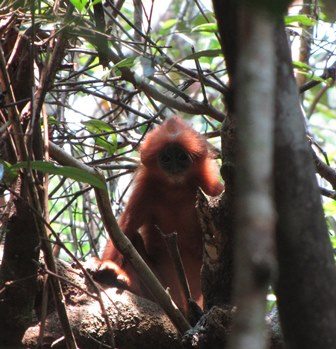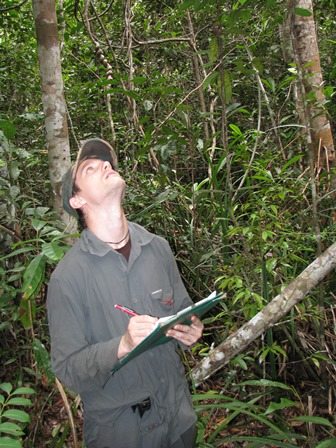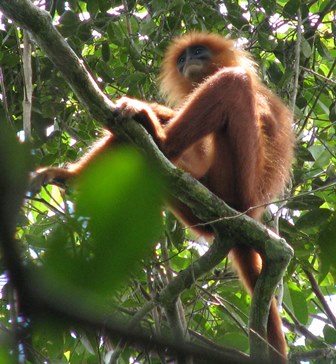As you know, we Act for Wildlife all over the world; including the South East Asian region. This next update comes from a project based in Malaysian Borneo, an island we’re familiar with through the conservation work we’re doing to protect the magnificent Bornean orangutan.
Borneo is home to many other endemic species of primate, including the red langur, which, like all of the wildlife found here, are threatened by habitat loss from the conversion of forests into agriculture.

In 2009, David Ehlers Smith, started the Sabangau Red Langur Research Project (SRLRP), and below he tells us more about this unique species of primate and the research work he’s doing around it:
“Borneo is the third largest island on Earth, and is identified as one of the world’s most important sites for biodiversity and endemism. However, it is also experiencing the highest rates of habitat destruction, conversion and deforestation due to our demands for tropical hardwoods and palm oil.
“OuTrop have been researching the ecology and conservation status of the endangered Bornean orangutan and Bornean southern gibbon in this fascinating and unique habitat for over ten years. I first arrived in Sabangau to manage the gibbon behavioural project. I quickly became captivated, however, by the red langur (Presbytis rubicunda), the gibbons’ small, red and very lively cousins that would often visit the gibbon groups during a day’s ‘follow’, and I knew from my MSc research that not much was known about this endemic monkey species.
“Indeed, at the time that my project began, only a couple of research sites had ever yielded published data on the red langur. Langurs belong to the colobine sub-family of monkeys; a group with specially adapted stomachs that allow them to break down tough, fibrous materials found in leaves and extract the nutrients inside.
“Typically, colobine monkeys feed on leaves 35-85% of the time, with the rest of their diet being made up of fruit parts. However, despite so little being known about this particular species, the IUCN’s Red List of Endangered Species states that they were Least Concern. This seemed worthy of further investigation, since so little was known about them, and their sympatric (species inhabiting the same forest) primate cousins were classified as endangered because of high rates of habitat loss. Since the langurs are experiencing the same habitat pressures, I wanted to find out more.

“Chester Zoo and the North of England Zoological Society provided me with a start-up grant that allowed me to get back into the peat-swamp field, and conduct surveys to estimate their population density. I quickly discovered that the peat-swamp environment, once thought depauperate in nutrients and biodiversity, actually contained the second highest population density of red langurs ever recorded (see my publication, here).
“A generous follow-up grant from Chester Zoo allowed me to establish the project long-term, and to investigate their behavioural ecology. This aspect is vital, as it both enhances our understanding of a species’ susceptibility to extinction, and also establishes the ecological parameters required to inform conservation management schemes.

“The results of this research proved to be both valuable and fascinating. It appears that a low fluctuation in the availability of fruits in the peat-swamp environment, so different from other habitats in Borneo that experience ‘mast-fruiting*’, has led to these ‘folivorous**’ colobines actually eating fruits approximately 85% of the time – the highest incidence of ‘frugivory***‘ ever found in colobine monkeys (see my paper, here).
*Mast-fruiting – synchronised mass fruiting and flowering events, interspersed by long periods of low food availability
**Folivorous – a herbivore that specialises in eating leaves. They tend to have long digestive tracts & slow metabolisms
***Frugivorous – an animal that feeds primarily on fruit
“Furthermore, this dietary adaptation seems to influence their ranging behaviour, as our population travels the furthest distances ever recorded in any monkey species with a folivorous adaption, on any continent (see my paper, here)!
“We continue to monitor the behaviour of our groups of langurs in Sabangau, and are branching out into research about how this shift in diet affects other aspects of the monkey’s ecology, and what this means for their evolutionary adaptation. In addition to answering these questions, I’ve taken a more desk-based approach to answering the initial conservation question: how endangered are these monkeys, given their endemic status on the world’s most at-risk island?
“Using specialised mapping software and the latest information on land-use policies, I sought to assess the threats within the distributions of Borneo’s colobine monkeys, and the effects of these on their conservation status. You can read about the findings of this new research, here.”